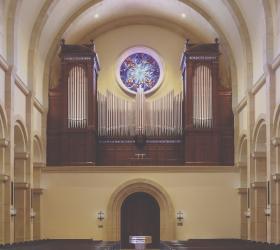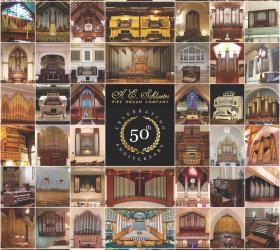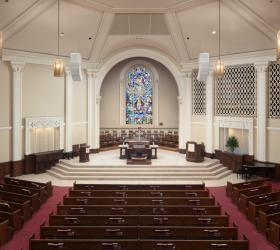
John-Paul Buzard Pipe Organ Builders, Champaign, Illinois, Opus 27
St. David's Episcopal Church,
Glenview, Illinois
From the builder
This instrument of 23 stops was installed and completed in
time for Easter Day, 2002. The church's limited ceiling height offered us quite
a design challenge. We wanted the instrument's design to assist the eye, to
give the illusion of greater height in a room in which the architecture did
not. Additionally, there was insufficient room in the balcony for the entire
organ. Therefore, the Swell and Pedal Organs are encased on the balcony floor,
but the Great Organ is housed in the smaller case overhanging the balcony rail.
The cases and console are made of beautiful dark walnut; the pipe shades in the
Great case are made of basswood. The façade pipes of the Great and Pedal
Principals are made of polished 75% tin. The roman mouths, round towers, and pipe
shades relate to the arched windows and the barrel vault ceiling. The Tuba is
made of polished copper, and is mounted horizontally off the pediment at the
top of the Swell case. Since its resonators tend to disappear into the shadows,
this somewhat "un-Georgian" feature does not disturb the proportions.
The instrument reflects my tonal aesthetic, in which the
organ's primary responsibility is to accompany singing and be an active and
full participant in the liturgy. To this end, the organ's tonal forces can be
smoothly built up in a seamless crescendo; unison pitched stops of softer
volumes are incorporated into the specification to offer a great variety of
accompanimental textures; a lyrical cantabile reed on each manual may be used
for obbligato playing and coloring of ensembles. The full swell has the
necessary "clang" to dramatically color the full organ, but can
accompany the choir when the shutters are closed. The Tuba, here voiced on 11 inches of wind, sings smoothly,
but commandingly, above the full organ for thrilling rendering of ceremonial
music.
The instrument plays solo organ literature of many styles
and periods with an innate musicality and warmth. The choruses are finely
balanced within themselves, and between divisions. The chorus reeds color the ensembles,
adding just enough fire in this close acoustical environment to spice things
up, but not overtake. The mixtures truly reinforce fundamental pitch, and
clarify ensembles, rather than confuse them.
It has been a privilege and honor to design and build this
new pipe organ for the people of Saint David's Church. Special thanks to their
Rector, The Rev. Graham Smith, music director Victoria Jicha, and the kind
parishioners and members of the organ committee and vestry who became
captivated by our somewhat unconventional visual design and layout, fell in
love with our tonal style, and worked tirelessly to prepare the space for the
new instrument.
Thanks also to my dedicated staff who
style="mso-spacerun: yes"> worked tirelessly to have the
instrument ready for Easter--in a year in which Easter came as early as
possible(!): Brian Davis, associate tonal director; Steve Downes, tonal
assistant; Charles Eames, general manager; JoAnne Hutchcraft, reception; Bob
Leach, cabinetmaker; Stuart Martin, cabinetmaker; Ken McCabe, winding system;
Evan Rench, shop manager and tonal assistant; Jay Salmon, office manager; Ray
Wiggs, windchests; Keith Williams, service manager.
--John-Paul Buzard
From the organist and choirmaster
The organ committee that met for the first time in August,
1999, was charged by the vestry to research the need for a new organ. The
committee produced an informative brochure, Sound Exultations, that outlined
the history of music at St. David's, defined the present musical needs of the
parish, and made recommendations for a new pipe organ. The pamphlet was
distributed to the congregation and meetings were held to answer any questions
that parishioners might have. With vestry approval committee members visited
many churches in the Chicago area during the next few months to hear organs by
various makers and invited five organ builders to submit proposals; four
companies responded affirmatively. Visits with these companies were scheduled
through out the summer of 2000, and by November it was clear that the design
submitted by Buzard Organ Builders was the most creative approach to an
inherent architectural problem-a limited ceiling height.
However, two more organ tours were scheduled-one in
December, and a second in January, 2001 to insure that the decision was
correct. Paul Frazer presented the committee's recommendation to the vestry in
February and a contract was signed with Buzard Pipe Organ Builders March 1,
2001.
The organ design required extending the loft into the nave
approximately eight feet, and the previous organ was removed during the summer
to begin the loft reconstruction. Worship services were led by the choir from
the front of the church, accompanied by a piano, from September 2001 until
early November when the loft construction was finished. March 4, 2002 the organ
arrived in thousands of pieces, and the installation was completed by Easter
Day, March 31st, 2002. The organ committee included Marilyn Berdick, Louise
Curry, Linné Dosé, Paul Frazer, Victoria Jicha, Debbie Lowe, Lonn
Myers, Graham Smith, Newland Smith, and Norman Smith.
-Victoria Jicha
Organist and Choirmaster
Saint David's Episcopal Church,
Glenview, Illinois
John-Paul Buzard Pipe Organ Builders, Opus 27
23 stops, 29 ranks
GREAT (4" wind)
16'
style='mso-tab-count:1'> Lieblich
Gedeckt (wood, in Swell case)
8'
style='mso-tab-count:1'> Open
Diapason (polished tin in façade)
8'
style='mso-tab-count:1'> Melodia
(open wood)
8'
style='mso-tab-count:1'> Gedeckt
Flute (from 16')
4' style='mso-tab-count:1'> Principal
4'
style='mso-tab-count:1'> Spire
Flute
22⁄3' style='mso-tab-count:1'> Nazard
2' style='mso-tab-count:1'> Fifteenth
13⁄5' style='mso-tab-count:1'> Tierce
11⁄3' style='mso-tab-count:1'> Fourniture IV
8'
style='mso-tab-count:1'> Corno
di Bassetto
Tremulant
Cymbalstern
(7 bells)
Chimes
(21 tubes)
8'
style='mso-tab-count:1'> Major
Tuba
8'
style='mso-tab-count:1'> Tuba
Solo
Gt/Gt
16-UO-4
Sw/Gt
16-8-4
SWELL (4" wind)
8'
style='mso-tab-count:1'> Stopped
Diapason (wood)
8' style='mso-tab-count:1'> Salicional
8'
style='mso-tab-count:1'> Voix
Celeste (TC)
4' style='mso-tab-count:1'> Principal
4'
style='mso-tab-count:1'> Harmonic
Flute
2' style='mso-tab-count:1'> Recorder
2'
style='mso-tab-count:1'> Full
Mixture IV
16' style='mso-tab-count:1'> Bassoon
8' style='mso-tab-count:1'> Trompette
8'
style='mso-tab-count:1'> Oboe
(ext)
8'
style='mso-tab-count:1'> Major
Tuba (Gt)
Sw/Sw
16-UO-4
PEDAL (4" & 41⁄2" wind)
32'
style='mso-tab-count:1'> Subbass
(1-12 digital extension)
32'
style='mso-tab-count:1'> Lieblich
Gedeckt (1-12 digital)
16'
style='mso-tab-count:1'> Bourdon
(wood)
16'
style='mso-tab-count:1'> Lieblich
Gedeckt (Gt)
8'
style='mso-tab-count:1'> Principal
(polished tin in façade)
8'
style='mso-tab-count:1'> Bass
Flute (ext)
8'
style='mso-tab-count:1'> Gedeckt
Flute (Gt)
4'
style='mso-tab-count:1'> Choral
Bass (ext)
16'
style='mso-tab-count:1'> Trombone
(41⁄2" wind)
16'
style='mso-tab-count:1'> Bassoon
(Sw)
8'
style='mso-tab-count:1'> Trumpet
(ext)
8'
style='mso-tab-count:1'> Major
Tuba (Gt)
Gt/Ped
8-4
Sw/Ped
8-4
A. E. Schlueter Pipe Organ Company
style='font-weight:normal'> of Lithonia, Georgia, has completed a new
instrument for Lumpkin United Methodist Church in Lumpkin, Georgia. This
congregation in rural Georgia pursued replacement of their electronic
instrument with several goals in mind. Foremost was the desire for the superior
sound of wind-blown pipes and the longevity of a pipe organ. Many of the organ committee
members were descendants of the founders or longtime members of this church and
they saw this project as an opportunity to provide an instrument for future
generations.
The placement of this instrument was a challenge because
there was no planned space for a pipe organ and no good location for the
console. The sanctuary is a half-round configuration with seating for 125
congregants. With proper placement of the organ, the intimacy and acoustics of
the room would allow the use of moderate scales and unforced voicing.
The former choir loft was immediately considered for
placement of the organ. It offered an offset right exposure that would allow
placement of the organ in proximity to the choir and worship center.
Furthermore, the adjacent non-parallel surfaces offered excellent dispersion of
organ tone throughout the sanctuary. Proving to be the ideal space, the niche
dimensioned at 10' of width, 5' of depth, and 14' of height, had in recent
years been used for the piano and electronic organ. To solve the problem of
console location, it was decided to provide an attached console. This location
of the organ resulted in the offset of four choir chairs that were moved to the
right and left forward of the organ case.
Architecturally the organ case is historically inspired and
evocative of design elements found in many southern rural churches around the
turn of the century. This blends well with the church architecture that is
itself a blending of many style elements found in Southern post-Reconstruction
architecture. The pipe shades are open carvings composed of interlocked arched
elements; they are gilded and ornament the pipe towers and upper organ case.
The gilding is antiqued to soften the visual impact of this otherwise strong
case element. The organ case was constructed of rift-sawn white oak finished to
match the sanctuary furnishings.
The tonal design of small instruments offers challenges that
are not present with larger instruments. The balance, timbre, weight, and
speech of each register take on greater importance inter and
intra-divisionally. Tonally the organ was conceived to provide the resources
that are normally found in a much larger instrument while maintaining
independence of choruses. It was determined that the two-manual instrument
should have a complete principal chorus, a flute chorus, a companion celeste
for the Viole de Gamba, an ensemble/solo Trompette, and adequate pedal
inclusive of two 16' registers--achieved within a 9-rank scheme.
In this design, it was important to maintain division
independence and to minimize octave parallel borrows within a division. For
example, the Great can be registered with flutes and principals at 8', 4', 2',
and Mixture II for congregational accompaniment without the presence of
parallel borrows. The organ is conceived as a one-manual instrument duplexed to
two manuals under one common expression (Principal 8'--unenclosed). This
expressive treatment allows unique duplexing of organ stops. The duplexing was
designed so that the Swell 8' Gedeckt plays as the 4' Gedeckt in the Great. The
Great 8' Koppelflute plays as the 4' Koppelflute in the Swell. This allows 8'
and 4' divisional independence. Stop design, mixed materials
style="mso-spacerun: yes"> (wood and metal), variable scales and
careful voicing allow for the full effectiveness of this tonal design. The
pedal division necessarily has the most duplexing. However, careful
registrations can allow manual and pedal independence.
Though small, the completed instrument embodies tonal
concepts key to all instruments that A. E. Schlueter Pipe Organ Company builds.
It is a revision and expansion of the eclectic American classic concept. Very
simply put, the tonal ideal is to have "warmth not at the expense of
clarity and clarity not at the expense of warmth."
The console drawknobs are of turned macasar ebony with
engraved insets. Other console features include tracker touch keyboards,
playback/record capability, and multi-level combination memory.
The completed instrument visually and tonally ties itself to
the sanctuary as it serves in worship. One of the finest compliments paid to
the firm was made by an elder member of the congregation: "It looks as if
it were designed with the building and has always been here. Now that it's
here, we can't imagine not having it."
A. E. Schlueter Pipe Organ Company (www.pipe-organ.com) can
be reached at P.O. Box 838, Lithonia, GA 30058, or via phone at 770/482-4845.
--Arthur E. Schlueter III
GREAT
8' style='mso-tab-count:1'> Principal
8'
style='mso-tab-count:1'> Koppelflote
(37 pipes, bass from Subbass)
8'
style='mso-tab-count:1'> Viola
(Sw)
8'
style='mso-tab-count:1'> Viola
Celeste TC (Sw)
4'
style='mso-tab-count:1'> Octave
(12 pipes)
4'
style='mso-tab-count:1'> Gedeckt
(Sw)
2'
style='mso-tab-count:1'> Fifteenth
(12 pipes)
11⁄3' style='mso-tab-count:1'> Mixture II
8'
style='mso-tab-count:1'> Trompette
(Sw)
Sw/Gt
SWELL
8' style='mso-tab-count:1'> Gedeckt
8'
style='mso-tab-count:1'> Viola
(49 pipes, 1-12 Ged)
8'
style='mso-tab-count:1'> Viola
Celeste TC (49 pipes)
4'
style='mso-tab-count:1'> Viola
(12 pipes)
4'
style='mso-tab-count:1'> Koppelflote
(12 pipes)
2'
style='mso-tab-count:1'> Waldflote
(24 pipes)
11⁄3' style='mso-tab-count:1'> Quint (54 notes)
II
style='mso-tab-count:1'> Sesquialtera
(37 pipes)
8' style='mso-tab-count:1'> Trompette
Tremolo
PEDAL
16' style='mso-tab-count:1'> Subbass
8'
style='mso-tab-count:1'> Principal
(Gt)
8'
style='mso-tab-count:1'> Gedeckt
(Sw)
4'
style='mso-tab-count:1'> Octave
(Gt)
4'
style='mso-tab-count:1'> Flute
(Sw)
16'
style='mso-tab-count:1'> Contre
Trompette (12 pipes)
8'
style='mso-tab-count:1'> Trompette
(Sw)
4'
style='mso-tab-count:1'> Clarion
(Sw)
Gt/Ped
Sw/Ped
Schoenstein & Co.,
San Francisco, California, has completed a two-manual, 11-rank organ for First
Church of Christ, Scientist in Belvedere, California. In the late 1930s G.
Donald Harrison and Walter Holtkamp each developed very interesting designs for
small churches that did not want unit organs. This instrument was inspired by
Harrison's design for a one-manual organ disposed over two manuals and pedal
with couplers. The choice and position of voices makes it quite versatile
despite its small size. The softer voices are in the open and the stronger ones
are under expression. The Flugelhorn is based on E.M. Skinner's successful
model. The church, designed in 1953 by renowned architect Warren Callister, is
one of the most respected examples of modern church design in America. An
important element of the project was making the instrument blend so perfectly
with the church fabric so as to make no intrusion on the lovely interior, which
has become a shrine for students of architecture. Mr. Callister worked closely
with Schoenstein, particularly on the console design, which is in a
"neo-craftsman" style and is made of oiled genuine mahogany. The
instrument comprises nine registers and 11 ranks on electric-pneumatic action,
18 speaking stops, 671 pipes.
--Larry Simpson
GREAT
8' style='mso-tab-count:1'> Principal
8'
style='mso-tab-count:1'> Bourdon
(Sw)
8'
style='mso-tab-count:1'> Viola
(Sw)
4' style='mso-tab-count:1'> Nachthorn
2' style='mso-tab-count:1'> Flageolet
Tremulant
Gt
4
Sw/Gt
16-8-4
SWELL
8' style='mso-tab-count:1'> Bourdon
8' style='mso-tab-count:1'> Viola
8' style='mso-tab-count:1'> Celeste
4' style='mso-tab-count:1'> Prestant
11⁄3' style='mso-tab-count:1'> Plein Jeu III
8' style='mso-tab-count:1'> Flugelhorn
Tremulant
Sw
16
Sw
4
PEDAL
16'
style='mso-tab-count:1'> Bourdon
(ext Sw)
8'
style='mso-tab-count:1'> Principal
(Gt)
8'
style='mso-tab-count:1'> Bourdon
(Sw)
8'
style='mso-tab-count:1'> Viola
(Sw)
4'
style='mso-tab-count:1'> Nachthorn
(Gt)
8'
style='mso-tab-count:1'> Flugelhorn
(Sw)
4'
style='mso-tab-count:1'> Flugelhorn
(Sw)
Gt/Ped
8
Sw/Ped
8




